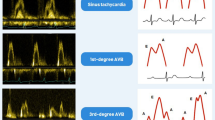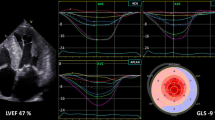Abstract
Vascular mechanics assessed with two-dimensional speckle tracking echocardiography (2D-STE) could be used as a new imaging surrogate of vascular stiffening. The CHA2DS2-VASc score is considered accurate as an estimate of stroke risk in non-valvular AF, although many potential stroke risk factors have not been included in this scoring method. The purpose of this research is to study the feasibility of evaluating vascular mechanics at the descending aorta in non-valvular AF patients using transesophageal 2D-STE and to analyze the association between descending aortic mechanics and stroke. We prospectively recruited a group of 44 patients referred for a transesophageal echocardiogram (TEE) in the context of cardioversion for non-valvular AF. A short-axis view of the descending aorta, one to two centimeters after the aortic arch was selected for the vascular mechanics assessment with the 2D-STE methodology. The vascular mechanics parameters analyzed were circumferential aortic strain (CAS) and early circumferential aortic strain rate (CASR). A clinical assessment was performed with focus on the past stroke history and the CHA2DS2-VASc score. The mean age of our cohort was 65 ± 13 years and 75% were men; AF was known for 2.8 ± 2.5 years and it was considered paroxystic in 41% of cases. Waveforms adequate for measuring 2D-STE were present in 85% of the 264 descending aortic wall segments. The mean CAS was 3.5 ± 1.2% and the mean CASR was 0.7 ± 0.3 s−1. The inter- and intra-observer variability for aortic mechanics was considered adequate. The median CHA2DS2VASc score was 2 (2–3). As the score increased we noted that both the CAS (r = −0.38, P = 0.01) and the CASR (r = −0.42, P < 0.01) decreased. Over 16% of the AF patients had a past history of stroke. These patients had lower values of both descending aortic strain [2.2 (1.8–2.6) vs. 3.9 (3.3–4.9)%, P < 0.01] and strain rate [0.4 (0.3–0.4) vs. 0.7 (0.6–1.1) s−1, P < 0.01]. CAS remained independently associated with a past history of stroke after adjustment for the CHA2DS2VASc score. Our data showed that non-valvular AF patients with a past history of stroke had lower values of aortic mechanics assessed with transesophageal 2D-STE.




Similar content being viewed by others
Abbreviations
- 2D-STE:
-
Two-dimensional speckle tracking echocardiography
- β1 :
-
Aortic stiffness index
- ε:
-
Strain
- AF:
-
Atrial fibrillation
- BSA:
-
Body surface area
- CAS:
-
Circumferential aortic strain
- CASR:
-
Circumferential aortic strain rate
- CHA2DS2-VASc score:
-
C-congestive heart failure; H-hipertension; A2-age >75; S2-stroke; V-vascular disease; A-age 65–75; Sc-sex category
- CoV:
-
Coefficient of variation
- EHRA:
-
European heart rhythm association
- HF:
-
Heart failure
- LA:
-
Left atrium
- LAA:
-
Left atrial appendage
- LAVI:
-
Lef atrial volume index
- LV:
-
Left ventricle
- LVEF:
-
Left ventricular ejection fraction
- NYHA:
-
New York heart association
- PWV:
-
Pulse wave velocity
- ROI:
-
Region of interest
- SR:
-
Strain rate
- TEE:
-
Transesophageal echocardiography
References
Teixeira R, Vieira MJ, Goncalves A, Cardim N, Goncalves L (2016) Ultrasonographic vascular mechanics to assess arterial stiffness: a review. Eur Heart J Cardiovasc Imaging 17(3):233–246
Mor-Avi V, Lang RM, Badano LP, Belohlavek M, Cardim NM, Derumeaux G et al (2011) Current and evolving echocardiographic techniques for the quantitative evaluation of cardiac mechanics: American Society Echocardiography/European Association of Echocardiography consensus statement on methodology and indications endorsed by the Japanese Society of Echocardiography. J Am Soc Echocardiogr 24(3):277–313
Larsson M, Verbrugghe P, Smoljkic M, Verhoeven J, Heyde B, Famaey N et al (2015) Strain assessment in the carotid artery wall using ultrasound speckle tracking: validation in a sheep model. Phys Med Biol 60(3):1107–1123
Larsson M, Heyde B, Kremer F, Brodin LA, D’Hooge J (2015) Ultrasound speckle tracking for radial, longitudinal and circumferential strain estimation of the carotid artery—an in vitro validation via sonomicrometry using clinical and high-frequency ultrasound. Ultrasonics 56:399–408
Kim SA, Lee KH, Won HY, Park S, Chung JH, Jang Y et al (2013) Quantitative assessment of aortic elasticity with aging using velocity-vector imaging and its histologic correlation. Arterioscler Thromb Vasc Biol 33(6):1306–1312
Camm AJ, Lip GY, De Caterina R, Savelieva I, Atar D, Hohnloser SH et al (2012) 2012 focused update of the ESC Guidelines for the management of atrial fibrillation: an update of the 2010 ESC Guidelines for the management of atrial fibrillation. Developed with the special contribution of the European Heart Rhythm Association. Eur Heart J 33(21):2719–2747
Camm AJ, Kirchhof P, Lip GY, Schotten U, Savelieva I, Ernst S et al (2010) Guidelines for the management of atrial fibrillation: the Task Force for the Management of Atrial Fibrillation of the European Society of Cardiology (ESC). Eur Heart J 31(19):2369–2429
Lip GY (2011) Stroke in atrial fibrillation: epidemiology and thromboprophylaxis. J Thromb Haemost 9(Suppl 1):344–351
Lip GY, Nieuwlaat R, Pisters R, Lane DA, Crijns HJ (2010) Refining clinical risk stratification for predicting stroke and thromboembolism in atrial fibrillation using a novel risk factor-based approach: the euro heart survey on atrial fibrillation. Chest 137(2):263–272
Dubois D, Dubois E (1916) A formula to extimate the approximate surface area if height and weight are know. Arch Inter Med 17:863–871
McMurray JJ, Adamopoulos S, Anker SD, Auricchio A, Bohm M, Dickstein K et al (2012) ESC Guidelines for the diagnosis and treatment of acute and chronic heart failure 2012: the Task Force for the Diagnosis and Treatment of Acute and Chronic Heart Failure 2012 of the European Society of Cardiology. Developed in collaboration with the Heart Failure Association (HFA) of the ESC. Eur Heart J 33(14):1787–1847
Evangelista A, Flachskampf F, Lancellotti P, Badano L, Aguilar R, Monaghan M et al (2008) European Association of Echocardiography recommendations for standardization of performance, digital storage and reporting of echocardiographic studies. Eur J Echocardiogr 9(4):438–448
Lang RM, Badano LP, Mor-Avi V, Afilalo J, Armstrong A, Ernande L et al (2015) Recommendations for cardiac chamber quantification by echocardiography in adults: an update from the American Society of Echocardiography and the European Association of Cardiovascular Imaging. J Am Soc Echocardiogr 28(1):1–39
Lang RM, Bierig M, Devereux RB, Flachskampf FA, Foster E, Pellikka PA et al (2005) Recommendations for chamber quantification: a report from the American Society of Echocardiography’s Guidelines and Standards Committee and the Chamber Quantification Writing Group, developed in conjunction with the European Association of Echocardiography, a branch of the European Society of Cardiology. J Am Soc Echocardiogr 18(12):1440–1463
Sohn DW, Song JM, Zo JH, Chai IH, Kim HS, Chun HG et al (1999 Nov) Mitral annulus velocity in the evaluation of left ventricular diastolic function in atrial fibrillation. J Am Soc Echocardiogr 12(11):927–931
Flachskampf FA, Badano L, Daniel WG, Feneck RO, Fox KF, Fraser AG et al (2010) Recommendations for transoesophageal echocardiography: update 2010. Eur J Echocardiogr 11(7):557–576
Ito T, Suwa M, Hirota Y, Otake Y, Moriguchi A, Kawamura K (1996) Influence of left atrial function on Doppler transmitral and pulmonary venous flow patterns in dilated and hypertrophic cardiomyopathy: evaluation of left atrial appendage function by transesophageal echocardiography. Am Heart J 131(1):122–130
Stefanadis C, Stratos C, Boudoulas H, Kourouklis C, Toutouzas P (1990) Distensibility of the ascending aorta: comparison of invasive and non-invasive techniques in healthy men and in men with coronary artery disease. Eur Heart J 11(11):990–996
Kim KH, Park JC, Yoon HJ, Yoon NS, Hong YJ, Park HW et al (2009) Usefulness of aortic strain analysis by velocity vector imaging as a new echocardiographic measure of arterial stiffness. J Am Soc Echocardiogr 22(12):1382–1388
Yuda S, Kaneko R, Muranaka A, Hashimoto A, Tsuchihashi K, Miura T et al (2011) Quantitative measurement of circumferential carotid arterial strain by two-dimensional speckle tracking imaging in healthy subjects. Echocardiography 28(8):899–906
Teixeira R, Moreira N, Baptista R, Barbosa A, Martins R, Castro G et al (2013) Circumferential ascending aortic strain and aortic stenosis. Eur Heart J Cardiovasc Imaging 14(7):631–641
Bland JM, Altman DG (1986) Statistical methods for assessing agreement between two methods of clinical measurement. Lancet 1(8476): 307–310
Shrout PE, Fleiss JL (1979) Intraclass correlations: uses in assessing rater reliability. Psychol Bull 86(2):420–428
Petrini J, Yousry M, Rickenlund A, Liska J, Hamsten A, Eriksson P et al (2010) The feasibility of velocity vector imaging by transesophageal echocardiography for assessment of elastic properties of the descending aorta in aortic valve disease. J Am Soc Echocardiogr 23(9):985–992
Tsai WC, Sun YT, Liu YW, Ho CS, Chen JY, Wang MC et al (2013) Usefulness of vascular wall deformation for assessment of carotid arterial stiffness and association with previous stroke in elderly. Am J Hypertens 26(6):770–777
Laurent S, Katsahian S, Fassot C, Tropeano AI, Gautier I, Laloux B et al (2003) Aortic stiffness is an independent predictor of fatal stroke in essential hypertension. Stroke 34(5):1203–1206
Masawa N, Yoshida Y, Yamada T, Joshita T, Sato S, Mihara B (1994) Morphometry of structural preservation of tunica media in aged and hypertensive human intracerebral arteries. Stroke 25(1):122–127
Heistad DD, Armstrong ML, Baumbach GL, Faraci FM (1995) Sick vessel syndrome. Recovery of atherosclerotic and hypertensive vessels. Hypertension 26(3):509–513
Bernhardt P, Schmidt H, Hammerstingl C, Luderitz B, Omran H (2006) Atrial thrombi-a prospective follow-up study over 3 years with transesophageal echocardiography and cranial magnetic resonance imaging. Echocardiography 23(5):388–394
Leung DY, Black IW, Cranney GB, Hopkins AP, Walsh WF (1994) Prognostic implications of left atrial spontaneous echo contrast in nonvalvular atrial fibrillation. J Am Coll Cardiol 24(3):755–762
Zabalgoitia M, Halperin JL, Pearce LA, Blackshear JL, Asinger RW, Hart RG (1998) Transesophageal echocardiographic correlates of clinical risk of thromboembolism in nonvalvular atrial fibrillation. Stroke Prevention in Atrial Fibrillation III Investigators. J Am Coll Cardiol 31(7):1622–1626
O’Rourke MF (2001) Diastolic heart failure, diastolic left ventricular dysfunction and exercise intolerance. J Am Coll Cardiol 38(3):803–805
Author information
Authors and Affiliations
Corresponding author
Ethics declarations
Conflict of interest
The authors have no conflict of interest to declare.
Ethical approval
This article does not contain any experimental studies with human participants or animals performed by any of the authors.
Electronic supplementary material
Below is the link to the electronic supplementary material.
Rights and permissions
About this article
Cite this article
Teixeira, R., Monteiro, R., Dinis, P. et al. Descending aortic mechanics and atrial fibrillation: a two-dimensional speckle tracking transesophageal echocardiography study. Int J Cardiovasc Imaging 33, 509–519 (2017). https://doi.org/10.1007/s10554-016-1028-4
Received:
Accepted:
Published:
Issue Date:
DOI: https://doi.org/10.1007/s10554-016-1028-4




